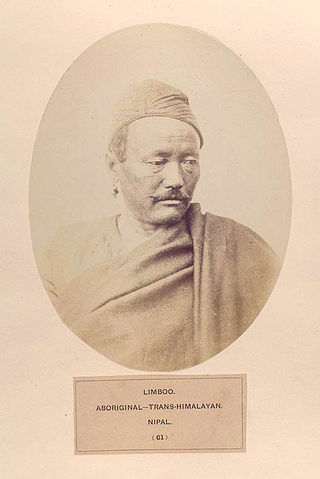
The Limbu or Yakthung (endonym) are a Tibeto-Burman ethnolinguistic group indigenous to the Himalayan region of eastern Nepal, Sikkim, Assam, Nagaland, northern West Bengal, and western Bhutan.
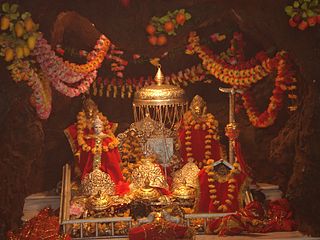
Vaishno Devi is a manifestation of the Hindu mother goddess Lakshmi sometimes in some beliefs Vaishno Devi is considered a manifestation of goddess Mahalakshmi. Vaishno Devi is worshipped as a combined avatar of the goddesses Mahakali, Mahalakshmi, and Mahasarasvati. Additionally, she is seen as the potency of Hari or Vishnu.

The history of Sikkim begins with the indigenous Lepcha's contact with early Tibetan settlers. Historically, Sikkim was a sovereign Monarchical State in the eastern Himalayas. Later a protectorate of India followed by a merger with India and official recognition as a state of India. Lepchas were the main inhabitants as well as the Ruler of the land up to 1641. Lepchas are generally considered to be the first people, indigenous to Sikkim also includes Darjeeling.
Iman Xin Chemjong Limbu, or Iman Singh Chemjong Limbu; was a Limbu historian, writer, linguist, lexicographer, folklorist, and philosopher of Nepal. Chemjong devoted his entire life to studying and documenting various facets of Kirat Limbu tradition and culture at a time when such activities were frowned upon and even punished by the Nepalese ruling elite as being subversive and "anti-national". Chemjong's research into and publication of Kirant history and culture challenged perceptions of the Nepalese official doctrine that showcased Nepal as a Hindu cultural monolith devoid of alternative narratives.
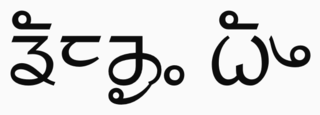
Limbu is a Sino-Tibetan language spoken by the Limbu people of Nepal and Northeastern India as well as expatriate communities in Bhutan. The Limbu refer to themselves as Yakthung and their language as Yakthungpan. Yakthungpan has four main dialects: Phedape, Chhathare, Tambarkhole and Panthare dialects.

The Lower Himalayan Range – also called the Middle Himalayas or Lesser Himalayas or Himachal – is a major east–west mountain range with elevations 3,700 to 4,500 m in the northernmost regions of the Indian subcontinent along the crest, paralleling the much higher High Himalayas range from the Indus River in Pakistan across northern India, Nepal and Bhutan but then the two ranges become increasingly difficult to differentiate east of Bhutan as the ranges approach the Brahmaputra River. The Himachal range also parallels the lower Shiwalik or Churia Range to the south. The Pir Panjal is the largest range of the Lesser Himalayas.

The Kirati people, also spelled as Kirant, are Sino-Tibetan ethnolinguistic groups and indigenous peoples of the Himalayas, mostly the Eastern Himalaya extending eastward from Nepal to Northern India (predominantly in the Indian States of Sikkim and Darjeeling & Kalimpong hills of northern West Bengal
Limbuwan is an area of the Himalayan region historically made up of 10 Limbu kingdoms, now part of eastern Nepal. Limbuwan means "abode of the Limbus" or "Land of the Limbus". Limbuwan was incorporated into the Kingdom of Nepal by means of a collective Gorkha-Limbuwan Treaty with the kings of the ten Limbuwan kingdoms and their ministers.

The corneal limbus is the border between the cornea and the sclera. It contains limbal stem cells in its palisades of Vogt. It may be affected by cancer or aniridia, among other issues. The limbal ring is a visible dark ring around the iris of the eye composed of darkened areas of the corneal limbus.
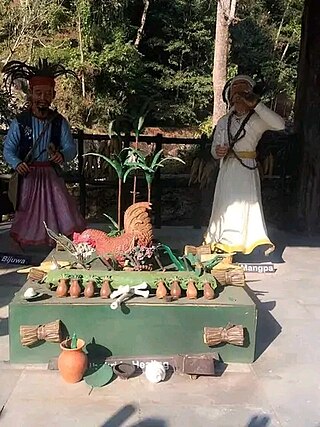
Kirat Mundum, also known as Kiratism, or Kirati Mundum, is an animistic folk religion of the Kirati ethnic groups of Nepal, Darjeeling and Sikkim, majorly practiced by Yakkha, Limbu, Sunuwar, Rai, Thami, Jirel, Hayu and Surel peoples in the north-eastern Indian subcontinent. The practice is also known as Kirat Veda, Kirat-Ko Veda or Kirat Ko Ved. According to some scholars, such as Tom Woodhatch, it is a blend of shamanism, animism, and Shaivism. It is practiced by about 3.17% of the Nepali population as of 2021.
Chainpur is a municipality in Sankhuwasabha District in the Koshi Province of north-eastern Nepal. It was formed by merging five villages i.e. Chainpur, Siddhakali, Siddhapokhari, Baneshwar and Kharang. The municipality was implemented on 18 May 2014. At the time of the 1991 Nepal census it had a population of 4933 people in 948 households.
Thukima is a village development committee in the Himalayas of Taplejung District in the Province No. 1 of north-eastern Nepal. At the time of the 1991 Nepal census it had a population of 2535 people living in 486 individual households.
Morahang is a village development committee in the Himalayas of Terhathum District in the Kosi Zone of eastern Nepal. At the time of the 1991 Nepal census it had a population of 3679 people living in 699 individual households.
Manahari is a Rural Municipality in Makwanpur District in the Bagmati Province of Nepal. At the time of the 1991 Nepal census it had a population of 10,013 people living in 1789 individual households.
Tye-Angsi Sirijanga Sing Thebe Limbu was an 18th-century Limbu scholar, educator, historian, linguist, leader, and philosopher of Limbuwan(Nepal) and Sikkim. He was formally known as Sirichongba and even more popularly known as "Sirijanga".
Himalaya Television, founded in 2010, is a nationwide private television company of Nepal. Himalaya TV has the state-of-art digital broadcasting equipment for production, post-production and broadcasting.

Jhākri is the Nepali word for shaman or diviner. It is sometimes reserved specifically for practitioners of Nepali shamanism, such as that practiced among the Tamang people and the Magars; it is also used in the Indian states of Sikkim and West Bengal, which border Nepal. The practice of using a Jhaakri as a channel or medium by a Hindu god or goddess to give solutions or answers to the questions of devotees is known as, "dhaamee " in Nepali.
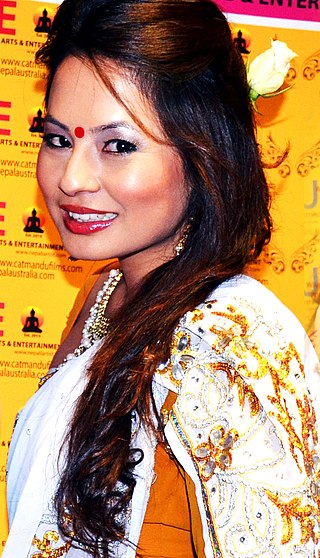
Malvika Subba (Limbu) (Nepali: माल्बिका सुब्बा (लिम्बु)) is a Nepalese media personality, beauty queen, actress, television host, social activist and entrepreneur. She graduated from Pokhara University with Masters in Mass Communication and Journalism.

Mahaguru Phalgunanda also known as "Mahaguru Phalgunanda" or Phalgunanda Lingden (1885–1949) was a leader of Kirat religion in Nepal Kirat people of Nepal.

The Voice of Nepal is a Nepalese reality show and the Nepalese format of the international TV singing reality series called The Voice. The show usually has four different coaches (judges), who eventually form four different teams after the selection event called the Blind Audition. Each team has to go through the battle round where contestants are paired with one another within the same team and only half of the total selected contestants from the blind audition are selected for the knockout round. During the knockout round, based on The Voice format, only the best and strongest contestants who their respective coach consider the best overall are selected by their coaches. They also have the sole right to do this on his or her own and take them to the live round. During the live round event, through a series of voting episodes, only one contestant with the most popular vote will advance to the grand finale. The first season of the voice of Nepal was won by CD Vijaya Adhikari from Team Deep, season 2 was won by Ram Limbu from Team Pramod and season 3 was won by Kiran Gajmer from Team Pramod. The Grand Finale of season 1 was held on 14 December 2018 in Quatar stadium, the second season's Grand finale was held at Taragaon Open Field Chuchchepati Kathmandu on 7 December 2019 and the third season's Grand Finale was held in The Voice Studio, Dhumbarahi. The voice of Nepal was bought by Himalaya Television.












